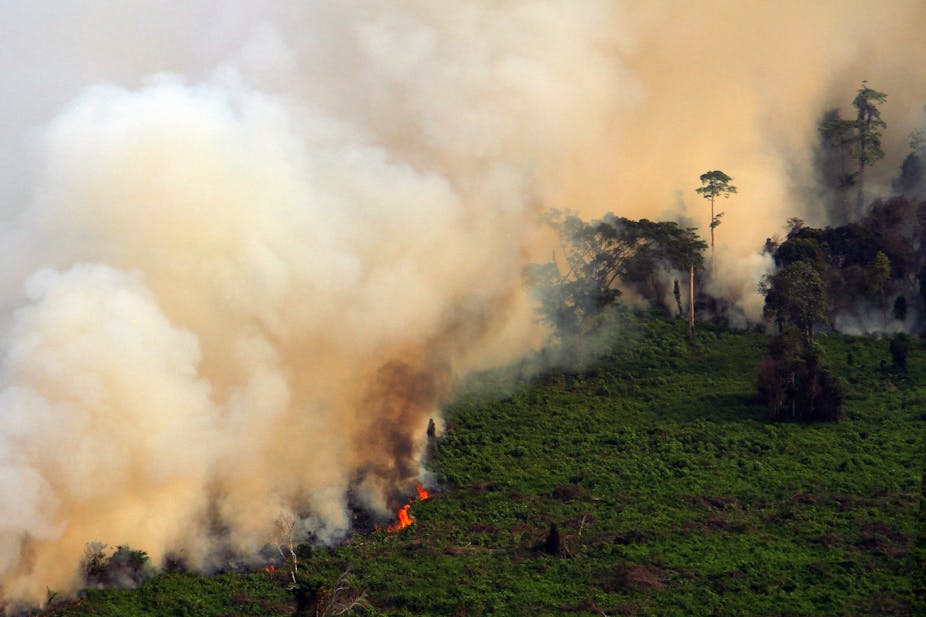Indonesia, one of the biggest forest destroyers in the world, is merging the country’s environment and forestry ministries, to the alarm of some local activists.
Activist are concerned that the merger will undermine conservation efforts.
The minister at the head of the merged departments is Siti Nurbaya Bakar, a former senior bureaucrat who also has training in environmental and regional development issues.
Forestry expert Martua T. Sirait says the change could be a good thing. Read our Q&A below.
How would merging the ministries impact on environmental policy in Indonesia?
The new ministry is called the Environment and Forestry Ministry, not the Forestry and Environment Ministry. That means the Forestry Ministry is joining the Environment Ministry, not the other way around.
With the environment being the lead focus, the merged ministry will take an environmental perspective, something that was introduced in Indonesia’s forestry sector only in 1998. This is new. The forestry sector has been using a timber-based exploitative perspective from the Dutch colonial era.
Indonesia’s Forestry Law has been revised from a timber-based perspective to an environmental one – a so-called ecosystem-based approach. But there has been a lack of enforcement. Now, with the change in structure, it’s possible to actually push for implementation.
It will not be an easy task, though. The environment ministry had 1600 staff. The forestry ministry had 17,000. This is why some activists are concerned that merging a small “good” ministry with a big “bad” one would be dangerous.
As long as the environment is the focus, this fear is not grounded. However, the minister will need to do a lot of work to change the culture.
How suited is Siti Nurbaya Bakar as environment and forestry minister?
There are a number of urgent matters concerning the environment and forestry that she can tackle based on her experience and capabilities.
First, there is an overlapping of 30,000 villages with so-called forest areas. This creates tension between the local communities and forest authorities, such as eviction or limits on access to their productive farms. As former secretary-general of Indonesia’s Home Ministry between 2001 and 2004, Nurbaya understands this quite well. I think she should be able to untangle this problem.
Second, she should be able to mainstream an environmental perspective on forestry issues. Nurbaya is a lecturer in the graduate program for environment and regional development at the Bogor Agriculture Institute. She will be able to transfer her knowledge to change the culture in the former forestry ministry to have a holistic rather than sectoral approach.
She would understand that the problem does not only lie in forest areas per se but the whole landscape. This includes maintaining and protecting biodiversity within the forests and outside forest areas such as peat land that has been converted for timber and palm oil plantations.
Third, as former head of the Lampung Province Development Agency (BAPPEDA), Nurbaya knows the mess in spatial planning in Indonesia. She should be able to tackle the tensions between local government, local communities and the ministry in developing provincial and district spatial planning in relation to land allocation for forest areas, local communities (in the rural areas) and other land users.
Fourth, she should be able to finally release a regulation on environmental thresholds (KLHS). Under Indonesia’s Environmental Protection Law 2009, each region should conduct a study on the environmental limits for opening large-scale timber and palm oil plantations and mines that might not harm the environment. A government regulation to implement this provision has never been released since 2009, and permits for large-scale activities were released without limit.
If each region has conducted its study and determined its threshold, they should not release more permits for large-scale industries than is safe for the environment. Under these circumstances, Indonesia could avoid polluting neighbouring countries such as Singapore, which suffer smoke hazards from land clearing for plantations in Sumatra and Kalimantan.

